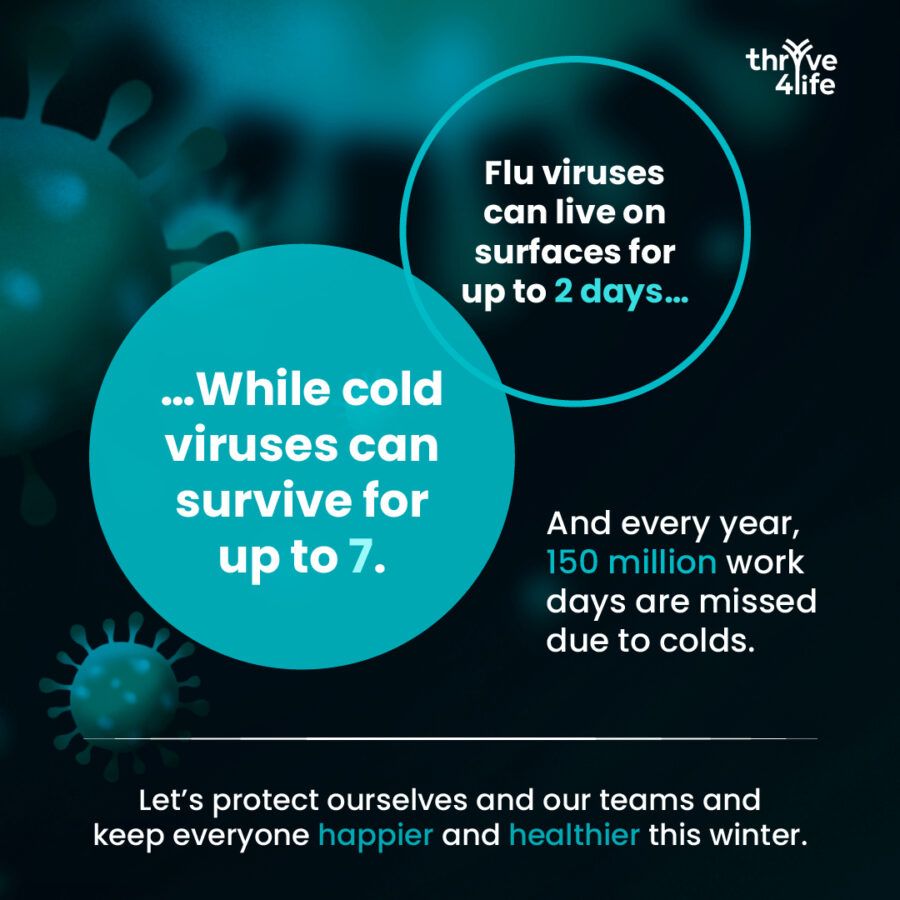With the colder months come crisp winds, hot drinks, autumn leaves, and other less pleasant visitors: coughs, colds, and flu. Complete with festive parties and school plays to attend, the run-up to Christmas and New Year often couldn’t be more hectic, and no one wants to fall ill. However, a cacophony of sneezing, sniffing, and coughing will likely resound across your workplace every year, with many employees falling ill during the winter months. Winter germs are often highly infectious, and a particularly virulent strain of flu can be debilitating, draining energy levels and leaving you or your employees fuzzy-headed, exhausted, and unable to work.
In this blog post, we’ll explore essential tips and tricks to help you and your colleagues combat, cope with, and recover from the flu and cold season in the workplace. We’ll also delve into common causes of infection and discover ways to safeguard our workplaces against germs and viruses, ensuring a healthier and happier winter for all.
Causes and Risk Factors:
Flu and colds are caused by the influenza virus. This virus targets the nose, throat, and lungs and is highly transmissible in enclosed, dry environments.₁ It spreads from one person to another via droplets, often airborne, which escape the body in the form of sneezes and coughs.₂ It can sometimes feel like winter germs spread around the office like wildfire. But why?
- Changes in weather: The sudden drop in temperatures means that we may not always have time to adequately prepare for the cold by dressing warmer, increasing our intake of hot drinks and fluids, and turning on the heating. Studies show that our body’s defences weaken in cold weather because the dry air inhaled prevents the tiny cilia lining the nasal and air passages from trapping viruses that can be breathed in.₃
- Returning from travel: Employees returning from their holidays may bring back infections from travel time spent in enclosed spaces on planes or trains.
- Enclosed office spaces: An enclosed workplace where employees work in close proximity to each other is an ideal breeding ground for viruses. The droplets which spread these germs can gather on surfaces, and computer equipment, and hang in recycled air. This means the layout of your office, particularly if you have crowded desk areas or limited ventilation, may well be putting your employees at a higher risk of coming down with a virus, as more of these droplets can be passed from one employee to another.
- Physical contact: It might be office etiquette to shake colleagues’ or clients’ hands, but handshakes are the perfect gateway for germs to transmit from one person to another as we use our hands to wipe our mouths, rub our eyes, and touch other parts of our faces. If you do need to shake hands, make sure you don’t touch your face afterwards and wash or sanitise your hands as soon as possible.
- Compromised immunity: Sitting in the office and working long hours indoors prevents employees from getting adequate sunlight and exercise. Lack of vitamin D and physical stimuli can weaken immunity, making individuals more susceptible to infection.
- Commuting: Travelling to work on crowded trains and buses can risk employees catching viruses from fellow passengers and spreading them around the office.

Now we know why winter germs can spread so easily around the office; it’s time to learn how we can protect ourselves and our teams from being struck down with a virus at one of the busiest times of the year.
Combatting Winter Viruses: Measures You Can Take to Protect Yourself and Your Team
Taking proactive measures to control and limit the spread of germs can help safeguard the health and well-being of every employee in your workplace. Small, targeted steps are needed to keep physical office spaces germ-free and empower employees with the necessary knowledge to boost their immunity and prioritise self-care and nutrition.
Thrive4Life’s top 5 recommendations to help you and your team dodge winter germs:
1. Keep the workplace clean: A clean workplace is a healthy workplace, leaving no room for germs to fester and contagions to spread. Hand sanitisers, surface wipes, and disinfectant sprays should be placed on all workstations for employees to use regularly throughout the working day. Infectious disease specialist Dr Couk says that computer spaces and work desks are the ‘germiest’ places in the office, as unlike bathrooms and kitchen areas, they are not regularly cleaned throughout the day.₄ Other commonly touched surfaces such as door knobs, desk handles, cabinets, and surfaces in shared kitchens or break rooms should also be sanitised and disinfected regularly. You should also open windows and draw back any curtains or blinds to ensure adequate sunlight and fresh air enter your workspace, providing ventilation which can help prevent the spread of airborne viruses.
2. Promote personal hygiene: Strong personal hygiene can limit the transmission of flu or other winter germs. This includes regular hand washing and sanitising, disposing of dirty tissues or wipes into no-touch designated bins, and covering your mouth and nostrils with a hanky or your elbow when sneezing or coughing. The NHS offers video and pictorial instructions on how to wash your hands to limit the spread of viruses.₅ These posters should be displayed in bathrooms and other areas with sinks.
3. Encourage rest and recuperation: Employees struck down with flu or other viral symptoms should be encouraged to take time off and regain their energy through proper rest. Coming into work when unwell will only make their symptoms worse, meaning they’ll take longer to recover, which has a knock-on effect on productivity, compromising the quality of work produced and increasing the risk of other colleagues becoming infected. Line managers should be vigilant, look out for signs of poor health amongst their team members (e.g., coughing, sneezing, etc), and encourage anyone under the weather to take proper sickness leave.
4. Have flexible work policies: Employees experiencing or recovering from flu-like symptoms may feel healthy enough to get on with their work tasks but might lack the energy to commute to and work in the office. If possible, allowing employees to work from home when they’re not feeling 100% helps care for their wellbeing, as this allows them to regain their health while reducing the risk of spreading germs around your workplace. Even if recovering employees feel healthier and fit to work, the average individual remains contagious 3-4 days after their illness begins.₆ This means that otherwise healthy people can still infect others around them. If there’s a significant rise in the number of flu cases in your office, flexible hours and staggered work shifts can also help curtail the spread of nasty germs by limiting the number of people in the office at a given time and allowing for spaced-out seating and physical distance between workstations to slow down the transmission of germs.
5. Prioritise nutrition: Vitamin D-packed foods such as fish, milk, and cod liver oil, as well as vitamin C-rich options like oranges, grapefruits, kiwi, and broccoli, can provide vital nutrients to boost the immune system and nourish anyone hit by the flu. Other hot fluids such as bone broth, chicken soup, and ginger/honey teas can soothe sore throats and ease congestion.₇ Educating your team about how to prioritise their nutrition and strengthen their immune systems is a vital step in protecting your employees during cold and flu season. You can do this by disseminating expert information on nutrition and immunity-boosting diets by providing your employees with access to e-learning health content in Thrive4Life’s Employee Health and Wellbeing Discovery Hub ₈, signing up your organisation to our health and wellbeing webinars run by medical consultants and experts in the field, or subscribing to our monthly health and wellbeing newsletters (link these services).₉
These simple steps prioritise preventative action, self-care, and recovery to keep employees healthy and thriving during flu season.
Knowing the Difference: Flu vs. Covid-19
The symptoms of Covid-19 overlap with many of the signs of flu and other winter viruses, meaning it can be tricky to distinguish between them. This means COVID-19 could spread across your workplace without infected individuals realising, which is another reason why it’s so important for unwell employees to take time off until they feel better.
The difference in symptoms between flu and Covid can be best explained by categorising the latter as ‘pandemic influenza’. As described by HSE, pandemic influenza shares similar symptoms to flu (headaches, nasal congestion, fever, coughing). However, it has higher infectivity over a larger geographical area, spreads more rapidly, and can be more prone to causing clinical illnesses in certain people.₁₀ To take the most appropriate measures for prevention and control in your workplace, it is important to be aware of the differences in symptoms. However, if you’re concerned you might have Covid, it’s vital that you test as soon as you can.
The common symptoms of influenza are: ₁₁
- Headaches
- Fever
- Cough
- Muscle aches
- Sore throat
The more serious and potentially complication-causing pandemic influenza (Covid-19) can be identified by: ₁₂
- High temperatures
- A persistent, continuous cough
- Changes to the sense of smell and taste
Employees experiencing one or more of these symptoms should be encouraged to work remotely (if well enough) or take time off to prevent the virus’ spread in the office. They should also be encouraged to take a diagnostic test and contact their GP, 111, or a pharmacist for further guidance if necessary. Other employees who have had contact with the infected individual should also be advised to take a test and remain vigilant of any developing symptoms. During peak winter virus season, senior management should also provide face masks for those who wish to wear them.
The Lowdown on Flu, Colds & Viruses
Flu, colds, and viruses might be common during the winter months, but they can seriously impact our physical and mental health and wellbeing. As we have discussed in this blog post, the flu virus’ high infectivity and propensity to survive and grow in enclosed spaces means that your office employees are not only more vulnerable to falling ill but also more likely to spread germs amongst each other. That is why taking precautionary measures to protect your team and minimise the many risk factors that accelerate the spread of bugs in the winter months is especially important. We hope the key insights and tips shared in this blog post will prove useful for your health and well-being strategies. Remember, being prepared for the winter months is the most essential thing: focusing on prevention and proactive measures to stop the spread of viruses amongst your team will help you and your employees push through flu season and enjoy Christmas and New Year to the full!
References
1. ‘Influenza – Symptoms and Causes’. The Mayo Clinic.
2. ‘Flu Causes: Types, Transmission, and Prevention’. Healthline.
https://www.healthline.com/health/flu-causes#transmission
3. ‘Can Cold Weather Really Make You Ill?’. Bupa UK.
www.bupa.co.uk/newsroom/ourviews/cold-weather-illness
4. ‘Preventing Colds and Flu at The Office’. Piedmont.
www.piedmont.org/living-better/preventing-colds-and-flu-at-the-office
5. The Best Way to Wash Your Hands’. NHS.
www.nhs.uk/live-well/best-way-to-wash-your-hands/
6. ‘Key Facts About Influenza’. Centers for Disease Control and Prevention
7. ‘Flu Diet: What to Eat When You Have The Flu’. Healthline.
www.healthline.com/health/what-to-eat-when-you-have-the-flu#foods-to-eat
8. Employee Wellbeing Hub. Thrive4Life.
www.thrive4life.co.uk/health-wellbeing-promotion/health-and-wellbeing-discovery-hub/
9. Educational Talks and Webinars. Thrive4Life.
www.thrive4life.co.uk/health-wellbeing-promotion/talks-and-webinars/
10. ‘Pandemic Influenza – Workplace Guidance’. Health & Safety Executive.
www.hse.gov.uk/biosafety/diseases/pandflu.htm#ref1
11. ‘Seasonal Influenza: Guidance, Data, and Analysis’. UK Gov.
www.gov.uk/government/collections/seasonal-influenza-guidance-data-and-analysis
12. ‘Covid-19 Advice and Services’. NHS










